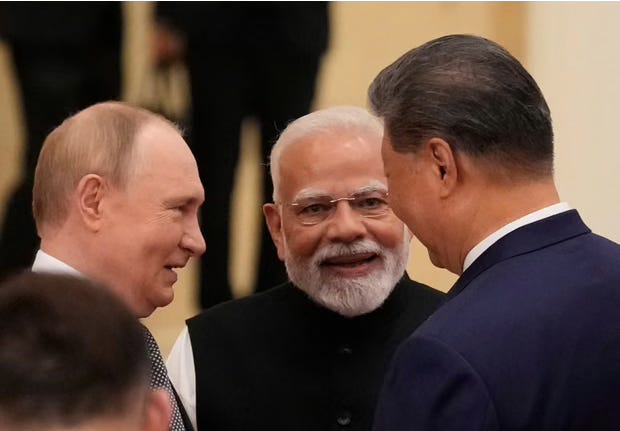Paralyzed World
For now, populists & autocrats remain in the ascendant
(‘Putin’, Modi & Xi chat at the Shanghai Cooperation Organization summit in Tianjin on Sunday, August 31, 2025. [Getty Images])
As a new political season opens, governments are mired in a costly immobility.
What? Elected leaders are feckless and autocrats a dead end? Such conclusions hardly count as original. This time may indeed be different as a deeper directionlessness, far beyond the usual drift, takes hold in many quarters.
Take the recent Shanghai Cooperation Organization (SCO) summit, which just wrapped up in Tianjin. With Modi attending for the first time in seven years, some (like Canada’s Globe & Mail) touted this year’s record turnout — more than twenty heads of state and government! — as evidence of an emerging power centre.
On closer inspection, the SCO remains more of a lonely hearts club for awkward bedfellows than a new crucible of global leadership. Modi is only courting China’s Xi, whose forces still actively threaten India’s borders, because he’s miffed at Trump’s tariffs. ‘Putin’ — ever desperate to look the part — alienated Peking with his antics in Alaska. The resulting thaw in Moscow’s relations with Washington has made China, whose exports to the US now face a 57.6 percent average tariff, less keen to bankroll ‘all-out’ support for Moscow’s war against Ukraine.
Chairman Xi is facing internal opposition of his own, as his economic dirigisme and fixation with Taiwan fuel quiet but stubborn forms of dissent. In recent months, a slow-motion, stealth challenge to Xi’s pre-eminence has been unfolding, led by the Central Military Commission, former general secretary Hu Jintao (publicly humiliated on Xi’s orders at a 2022 party congress), and other disgruntled princelings.
Tomorrow’s parade to mark the 80th anniversary of China’s victory is unlikely to produce new glue. After all, the Chinese Communist Party spent most of the war undermining the nationalist Kuomintang; Indian nationalists identified with the Axis; and today’s Kremlin has rekindled Russian enthusiasm for invasions, spheres of influence and their suicidal 1939 alliance with Nazis.
In Moscow itself, the federal deficit and inflation are at record highs amid gasoline shortages caused by Ukrainian attacks on Russian refineries. For the Kremlin, the follow-up to Anchorage has produced, at best, thin gruel.
In Europe, populists in the UK, France, Germany, Italy and elsewhere complain governments spend too little on nationals while welcoming too many migrants. Meanwhile, skeptical bond markets are raising their cost of borrowing.
Even in the US, where markets are still relatively buoyant, uncertainty over Trump’s monetary, spending and tariff policy is growing. Will the current boom in equity prices and AI-related investment turn out to be another asset price bubble? How far will Project 2025 roll back democratic and legal norms, including free speech?
That we must ask such questions is itself dismaying.
Meanwhile, Trump’s tariffs slowed second-quarter GDP growth dramatically in Brazil and Canada. At current oil price levels, Saudi Arabia is facing budget shortfalls for its ambitious infrastructure programme, including a new capital. Russia may not be able to sustain current military spending levels into 2026.
While Iran’s terrorist proxies have been mostly cut down to size, Iran’s nuclear ambitions and a post-Hamas future future for Gaza have received precious little serious policy attention. In the meantime, the world’s leading terrorists seem to be preparing in Afghanistan, Syria and elsewhere for new strikes.
Three big assumptions have changed. First, allied democracies seem chronically unprepared and unwilling to take military action on any front. Second, after imbibing the Kool-aid of Modern Monetary Theory for a decade, most major economies are now feeling the sting of higher borrowing costs. Third, after decades of trade liberalization, the US has – for now at least – retreated behind a tariff wall.
The global trading system is not yet falling apart. But it is in disarray, as it grapples with the twin headwinds of China-led mercantilism and US-led protectionism, the latter now revived on a scale not seen in a century.
Missing from this stasis-inducing equation is leadership. In the absence of the US, who will show that democracy works better? Are there US or G7 politicians that can put populists and would-be autocrats like Trump in their places?
Who will stand up for rules-based trade and macroeconomic stability in a world where beggar-thy-neighbour policies are spreading? Apart from Ukraine, which allies are ready to use military force and embargo to stop aggression in its tracks – once Trump’s dilatory ‘peace process’ is fully exposed as the fever swamp it is?
For now, populists and autocrats dominate a listless global scene. Who can break this logjam by injecting focus and urgency into issues that matter most?
Smaller countries, opposition politicians, new governments and business leaders have scope to do much more. The Diehard Optimist will be cheering them on.



